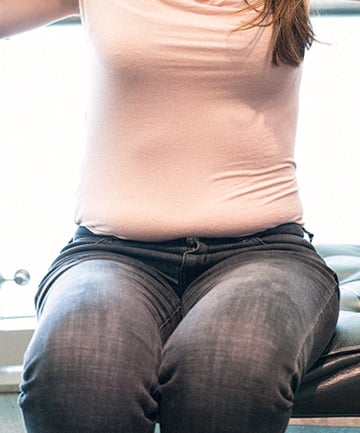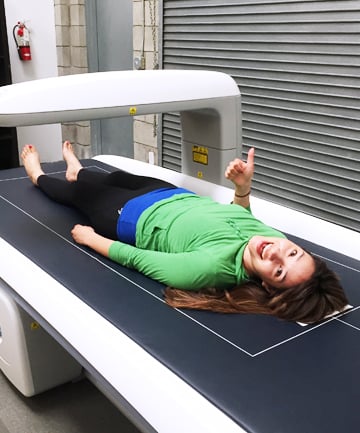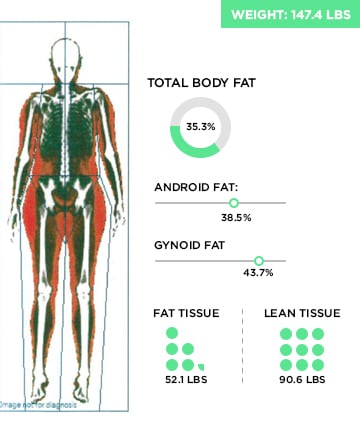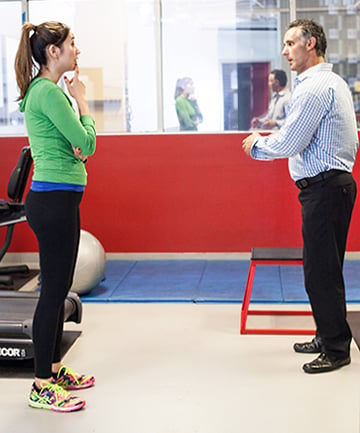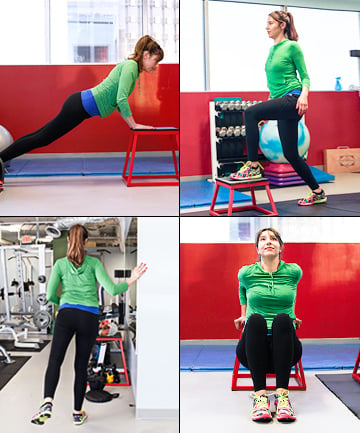And while these shots might spark rumors if I were a celebrity, they're merely pictures of my food baby (sorry, Mom!). Like a lot of women, I carry most of my fat in my lower abdomen -- a notoriously hard area to trim.
But listen, I get it. In this age of filters, Facetuning and finding the right angle, a photo isn't exactly reliable. So, I got the scientific lowdown on my love handles from BodySpec, which offers a dual X-ray absorptiometry (DXA) scan that measures body fat and lean muscle.
At the end of the scan, I got a visual representation of my skeleton, where red symbolizes my fat and green represents my muscle. And believe me, ain't no Instagram filter that can alter the readings on this photo.
The result?
At the end of the scan, I got a visual representation of my skeleton, where red symbolizes my fat and green represents my muscle. And believe me, ain't no Instagram filter that can alter the readings on this photo.
The result?
A whole lot of red, i.e. fat. I mean, look at that sad little sliver of green on my arms. It's almost non-existent.
I also got a comprehensive region-by-region percentage breakdown of exactly how much fat I was storing in every part of my body -- from my spaghetti arms to my gynoid (that's the hips, upper thighs and booty area). Most concerning was the amount of unhealthy visceral fat that I was carrying in my android or abdominal area. According to the BodySpec staff, visceral fat should be as close to zero as possible, since this is the type of fat that is associated with metabolic diseases, like type 2 diabetes. But BodySpec staff advise that, at the minimum, android fat should be leaner than the rest of your body (you don't want a disproportionate amount of fat residing in your belly and weighing on your organs). At 38.5 percent fat, my android region was fattier than the rest of my body, which consisted of 35.3 percent fat.
I also got a comprehensive region-by-region percentage breakdown of exactly how much fat I was storing in every part of my body -- from my spaghetti arms to my gynoid (that's the hips, upper thighs and booty area). Most concerning was the amount of unhealthy visceral fat that I was carrying in my android or abdominal area. According to the BodySpec staff, visceral fat should be as close to zero as possible, since this is the type of fat that is associated with metabolic diseases, like type 2 diabetes. But BodySpec staff advise that, at the minimum, android fat should be leaner than the rest of your body (you don't want a disproportionate amount of fat residing in your belly and weighing on your organs). At 38.5 percent fat, my android region was fattier than the rest of my body, which consisted of 35.3 percent fat.
Armed with my stats, I paid bodybuilder and trainer Dr. Robert Pomahac, founder of MaxHealth LA, a visit to create a 10-minute exercise regimen designed to tone my lower belly, arms and butt.
He prescribed a workout plan that interspersed resistance training with cardiovascular training. "The more muscle you have, the better your body can burn fat," Pomahac explained. To provide a "break" between resistance sets -- and make sure I didn't keel over from doing back-to-back resistance moves after not having picked up a weight in months -- he had me jump rope. "Then you're incorporating your cardiovascular -- skipping rope -- as a break component from the resistance training to give yourself a bit of a time to recuperate and to make sure that you're doing the muscle training properly."
I had to try to reach 80 percent of my maximum heart rate (calculated by subtracting your age from 220 and then multiplying that number by .80) when doing the routine. Here's what the plan looked like in its entirety:
Lunges (15 reps per leg)
Jump rope for 30 seconds
Close-grip pushup (15 reps)
Jump rope for 30 seconds
Wide pushup
Jump rope for 30 seconds
Bicep curl (15 reps per arm)
Jump rope for 30 seconds
Leg lift (15 per leg)
Jump rope for 30 seconds
Stool step-ups (15 reps per leg)
Jump rope for 30 seconds
Seated isometric ball squeeze (15 reps using a throw pillow as a substitute)
Jump rope for 30 seconds
Triceps dips (15 reps)
Looks pretty straightforward, right? So, how did I fair with my 10-minute routine (and should you try it, too)?
I had to try to reach 80 percent of my maximum heart rate (calculated by subtracting your age from 220 and then multiplying that number by .80) when doing the routine. Here's what the plan looked like in its entirety:
Lunges (15 reps per leg)
Jump rope for 30 seconds
Close-grip pushup (15 reps)
Jump rope for 30 seconds
Wide pushup
Jump rope for 30 seconds
Bicep curl (15 reps per arm)
Jump rope for 30 seconds
Leg lift (15 per leg)
Jump rope for 30 seconds
Stool step-ups (15 reps per leg)
Jump rope for 30 seconds
Seated isometric ball squeeze (15 reps using a throw pillow as a substitute)
Jump rope for 30 seconds
Triceps dips (15 reps)
Looks pretty straightforward, right? So, how did I fair with my 10-minute routine (and should you try it, too)?
You know how with most workouts, you look at the clock and can't believe how slowly time is moving? Like, OMG, how have I only spent 5 minutes on the elliptical? Well, that definitely doesn't happen with this workout. It took me close to 20 minutes to get through the entire routine the first time, because I had to check my posture and reference my notebook so many times. And I couldn't believe how few of the exercises I could actually do in 10 minutes. Oh, and I almost died trying to do the pushups.
And speaking of my target heart rate, I'm not sure that I ever did reach it. It just didn't seem impractical to pause within the short time allotted for the workout to measure it -- and I definitely wasn't going to drop any money on a fitness tracker. Plus, one of the reasons I took on this fitness challenge was to test it out for the all of the real, similarly busy people out there, who want a fuss-free workout.
And speaking of my target heart rate, I'm not sure that I ever did reach it. It just didn't seem impractical to pause within the short time allotted for the workout to measure it -- and I definitely wasn't going to drop any money on a fitness tracker. Plus, one of the reasons I took on this fitness challenge was to test it out for the all of the real, similarly busy people out there, who want a fuss-free workout.


